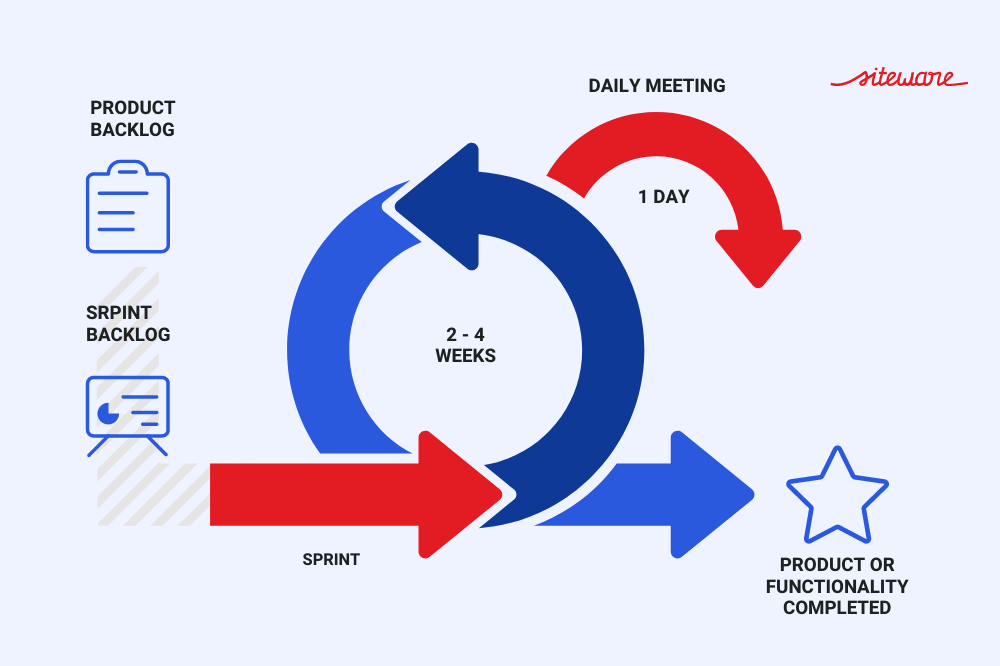
Many types of agile methodology have been developed over the years in order to ensure more business efficiency, less financial costs for operational processes, and higher customer success rates.
These methods help organizations to optimize internal operations, speed up project implementation and reduce unnecessary expense. Combined, all of these elements have a huge impact on business results.
According to PMI´s Pulse of the Profession research, 73% of the organizations around the world invest in agile methodology to manage their projects.
In this context, managers wish to acquire a deeper knowledge on how to apply the different types of agile methodology to achieve their goals faster and more effectively.
Below, you’ll find the 7 types of agile methodology that will turn your business more profitable and efficient! Keep reading!
An agile methodology is a method that combines skills and practices used in project management in order to guarantee more speed, efficiency, and flexibility. It helps to organize the project into different phases, promote constant team collaboration and continous improvement to achieve better results.
This method was initially developed for software companies. However, due to its capacity to optimize general processes, it took over several other segments.
Nowadays, any organization can implement agile methodology to handle its processes and make them simpler and more dynamic.
The main characteristics of an agile methodology are:
Agile methodologies help companies to eliminate bottlenecks and speed up projects. The result is high quality products or services in a timely manner.
According to The Agile Project Delivery Confidence Report, when projects are implemented using an agile methodology, they are 28% more successful than those led through conventional methods.
The main values of agile methodologies are better described in the Agile Manifesto. Check it out!
In 2001, a group of 17 professionals looking to improve customer success by creating faster and more effective organizational processes, created the Manifesto for Agile Software Development.
This document transmitted (and still does) the best practices related to software development based on the following principles:
These values clearly expose the agile methodology’s essence: delivering a quality product and high rates of customer experience, even if it requires changing the plans’ direction along the way.
Agile Manifesto founders established the following 12 principles that can be extended to any kind of business:
Now that you know what an agile methodology is, it’s time for you to learn about the 7 types of agile methodology most used in business.
Let’s check each of them out!

We couldn’t start our list without mentioning Kanban, which is one of the oldest types of agile methodology.
It was inspired by a Japanese system in order to organize workflow within industries. The Kanban method was created in the 1960s and its main goal is to synchronize storage with production by signaling cards that show the products’ status.
Offices usually replicate this system with boards and post-its that were later replaced by digital platforms, like Trello.
Trello reproduces this system in a very agile way. The platform allows to elaborate simple charts that display tasks, projects and responsibilities for each team member.
Lean is a management philosophy introduced by the automotive sector. Its intention is to ensure lean and efficient product development.
Resources and time application are minimal in order to achieve high cost reduction. Therefore, all production’s leftovers are cut out to reduce complexity and to optimize results.
In this method, the entire team has a clear and understandable workflow. Moreover, deliveries are fast due to the agility in identifying bottlenecks throughout the production flow.
As a result, the company becomes more competitive and prosperous in its market segment. The main principles of this methodology are:

Scrum is one of the most versatile and complex types of agile methodology and it is capable of optimizing several types of projects.
Launched in 1990, it offers a dynamic team’s organization linked by a common goal, which may be software development or product creation.
The method has 3 clear functions: Product Owner, Scrum Master, and the Development Team.
The Product Owner is the leader and responsible for coordinating the development team and managing the product backlog.
The Scrum Master orientates processes and ensures that everyone understands and applies Scrum correctly.
The development team includes five to ten people who need to find problem’s solutions and execute tasks.
This methodology is divided into sprints, which are speeded up work cycles that deliver results in a short period of time. Thus, each project has several sequential sprints until it ends.
Finally, a term widely used in Scrum is the Backlog, which represents the continuous development of a set of product features as the project goes on.
Extreme Programming, also known as XP, is one of the types of agile methodology focused on software engineering and it is also very similar to Scrum.
However, while Scrum focuses on management practices, XP emphasizes on technical functions. Its main goal is to bring out good software development practices into daily operations.
In this sense, the method follows some principles, such as:
XP has short cycles in order to reduce uncertainties and risks. Also, it adopts continuous improvement of code, testing and integration.
For this purpose, the company collects constant customer feedback. Usually, the clients accompany every cycle throughout the process so they can request as many modifications as they want.
Some companies tend to combine Scrum with XP to achieve an even more effective project development.
Learn more about Extreme Programming with the video below 👇:
Feature Driven Development is one of the main types of agile methodology. It was created in the late 90s by Jeff de Luca, an IT strategist.
This technique brought to light the idea of development through features by considering five basic processes:
Some organizations combine FDD with Scrum, as they apply the feature method in each sprint in order to improve task planning.
The Dynamic Systems Development Method (DSDM) is an agile methodology created in the IT industry in the early 90s. It works as a framework used in software development with continuous customer participation.
It has three phases: pre-project, project, and post-project.
The identification of the project and the budget preparation happen in the pre-project phase. This stage demands seeking maximum rationality of resources.
Next, the project phase initiates the processes viability studies by considering functional and economic issues. Then, it must create incremental prototypes in order to demonstrate product functionality to customers.
It’s important to follow these stages along with frequent feedback cycles until the product reaches final implementation. Meanwhile, continuous maintenance and adjustments will be made if necessary.
This is a type of agile methodology developed for more complex projects. It promotes iterative and incremental cycles and it also demands constant customer involvement throughout the process.
This method follows six principles:
Any methodology can fit well in any kind of business, although some of them may have a slightly greater focus on the IT segment.
The different types of agile methodology can be applied to any kind of business, even though originally they focus on the TI sector. All you need to do is adapt the chosen methodology to the context of your own business to optimize the processes and achieve better results.
As you know now, there are several types of agile methodology that may be more suitable to your business reality as well as to achieve team engagement.
That said, it is essential to understand that the application of any methodology needs to be boosted by management softwares that helps managers to:
In this context, Siteware offers STRATWs One, a platform which connects your company with the customer by optimizing time for planning, organizing routines and engaging the entire team in order to achieve business goals.
Ask for a free demonstration of STRATWs One:

Your technology partner to connect you to what really matters.